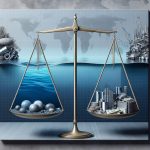Inflation in the United States has accelerated, tempering the case for rate cuts by the Federal Reserve. The consumer price index (CPI) rose by 3.4% in the year through December, marking the highest increase in three months. This surge in inflation was driven by persistent services costs, while the decline in goods prices tapered off. Additionally, housing costs continued to climb, Americans paid more for transportation, and energy prices advanced for the first time since September.
The Consumer Price Index Shows Significant Growth
According to government figures, the consumer price index (CPI) surged by 3.4% in the year through December. This notable increase, the highest in three months, indicates a significant rise in inflation. The CPI measures the average change in prices over time for goods and services purchased by households. It serves as a crucial indicator for gauging inflationary pressures on the economy.
Factors Contributing to the Acceleration of Inflation
Several factors contributed to the acceleration of inflation in the United States. Firstly, services costs remained stubbornly high, driving up overall price levels. This includes expenses related to healthcare, education, and housing. The rising costs of these essential services have had a substantial impact on the CPI.
Moreover, the decline in goods prices, which had been observed in previous months, began to stabilize. This stabilization in goods prices further contributed to the overall increase in inflation. The end of the decline in goods prices suggests a potential shift in the market dynamics, possibly indicating a more balanced pricing environment.
Housing Costs Continue to Climb
One of the key drivers of inflation in the United States is the continuous climb in housing costs. Housing expenses, including rent and home prices, have been steadily rising, putting pressure on overall inflation levels. This trend has been particularly prominent in major cities and high-demand areas, where housing scarcity drives up prices. As a result, consumers are experiencing a higher cost of living, leading to an increase in the CPI.
Transportation Costs on the Rise
Transportation costs also contributed to the acceleration of inflation in the United States. Americans paid more to drive, with fuel prices surging and the cost of vehicle maintenance and repairs increasing. As transportation is an essential aspect of daily life for most individuals, the rise in these costs directly impacts consumer spending and overall inflationary pressures.
Energy Prices Experience an Upturn
In a noteworthy shift, energy prices in the United States advanced for the first time since September. This upturn in energy prices played a role in driving up the overall inflation rate. Although energy prices are prone to fluctuations due to various factors such as global supply and demand dynamics and geopolitical events, the recent increase indicates a potential upward trend in energy costs. This development is significant as energy expenses have a broad impact on the economy, affecting both businesses and consumers.
Implications for the Federal Reserve’s Rate Cuts
The acceleration of inflation in the United States has significant implications for the Federal Reserve’s decision-making process regarding interest rates. The Federal Reserve closely monitors inflationary trends as part of its mandate to ensure price stability and maximize employment. The surge in inflation may influence the Federal Reserve to reconsider its stance on rate cuts.
If inflation continues to rise, the Federal Reserve may opt for a more hawkish approach, potentially pausing or even reversing its rate-cutting cycle. This would aim to curb inflationary pressures and maintain price stability within the economy. However, the decision ultimately depends on a comprehensive analysis of various economic indicators and the overall health of the economy.
See first source: Bloomberg
FAQ
Q1: What is the Consumer Price Index (CPI), and why is it important?
A1: The Consumer Price Index (CPI) measures the average change in prices over time for goods and services purchased by households. It is essential because it serves as a crucial indicator for gauging inflationary pressures on the economy, reflecting how prices of everyday items are changing.
Q2: How much did the CPI increase by in the year through December, and why is it significant?
A2: The CPI increased by 3.4% in the year through December. This is significant as it marks the highest increase in three months, indicating a notable rise in inflation, which can have various economic implications.
Q3: What factors contributed to the acceleration of inflation in the United States?
A3: Several factors contributed to the acceleration of inflation, including persistently high services costs (e.g., healthcare, education, and housing), stabilization in goods prices, climbing housing costs, rising transportation costs, and an upturn in energy prices.
Q4: How are housing costs impacting inflation?
A4: Housing costs, including rent and home prices, have been steadily rising, putting pressure on overall inflation levels. This trend is particularly prominent in major cities and high-demand areas, where housing scarcity drives up prices.
Q5: What role do transportation costs play in inflation?
A5: Transportation costs contribute to inflation as Americans pay more for fuel, vehicle maintenance, and repairs. Transportation is essential in daily life, so rising costs in this category directly impact consumer spending and overall inflation.
Q6: Why is the upturn in energy prices significant for inflation?
A6: The upturn in energy prices is significant because it played a role in driving up the overall inflation rate. Energy expenses have a broad impact on the economy, affecting both businesses and consumers.
Q7: How might the acceleration of inflation influence the Federal Reserve’s rate-cutting decisions?
A7: The surge in inflation may influence the Federal Reserve to reconsider its stance on rate cuts. If inflation continues to rise, the Federal Reserve may adopt a more hawkish approach, potentially pausing or even reversing its rate-cutting cycle to curb inflationary pressures and maintain price stability. However, the decision depends on a comprehensive analysis of various economic indicators and the overall health of the economy.
Featured Image Credit: Photo by rc.xyz NFT gallery; Unsplash – Thank you!







